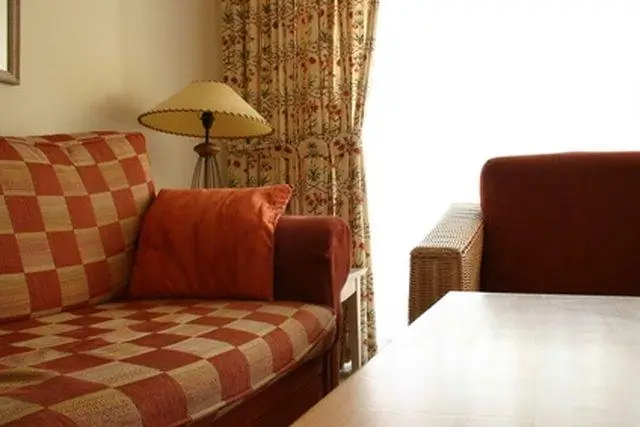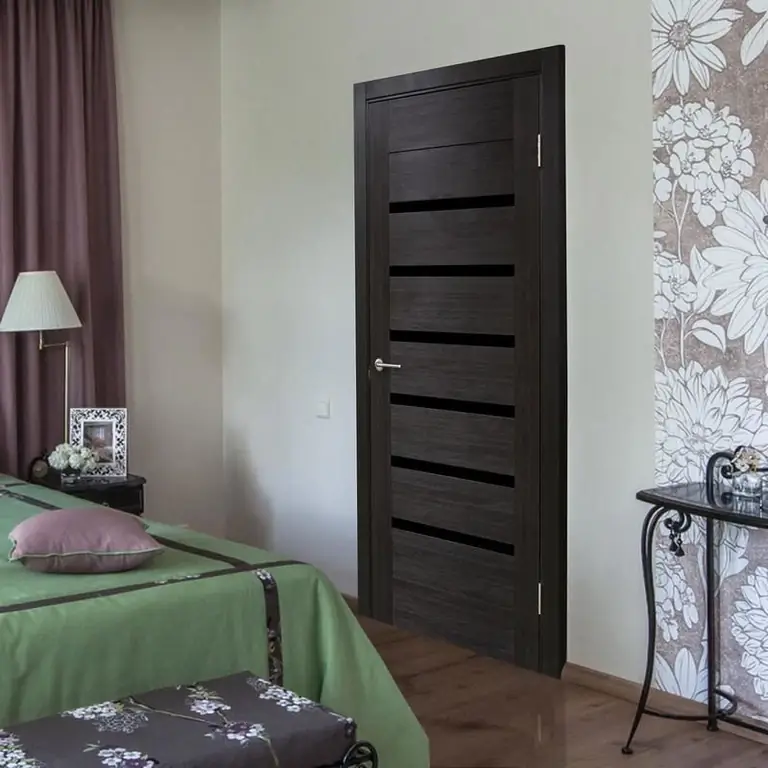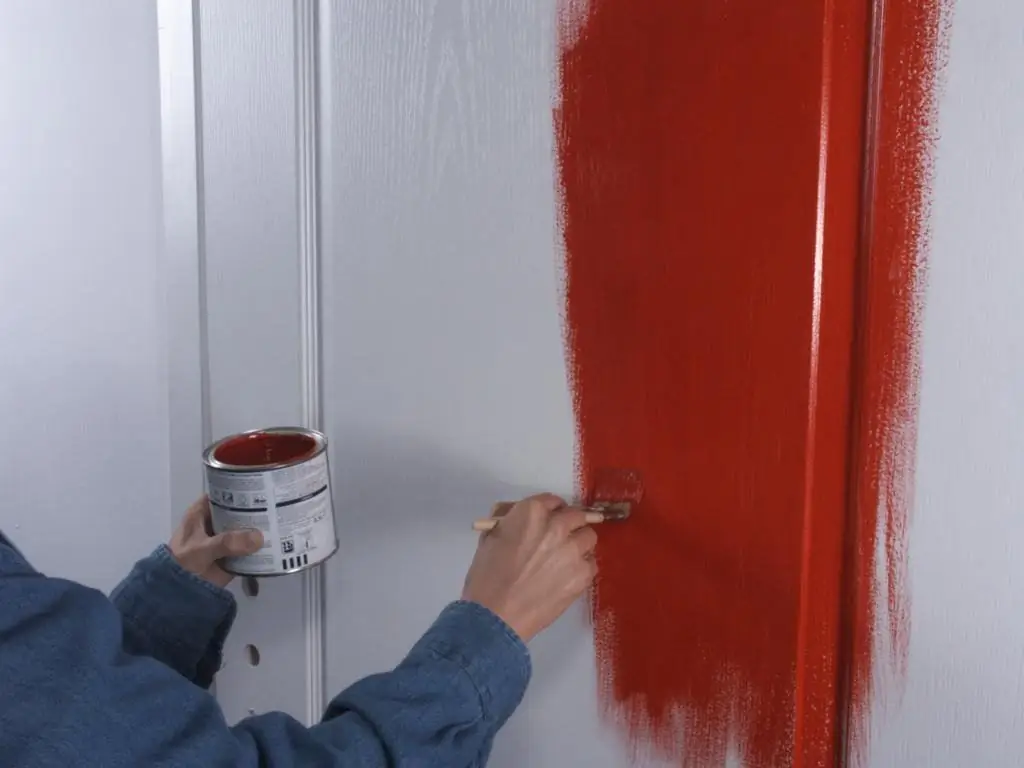
Table of contents:
- Author Bailey Albertson [email protected].
- Public 2023-12-17 12:53.
- Last modified 2025-01-23 12:41.
How to paint interior doors: processing technology and choice of funds

You can add aesthetics to interior doors from different materials using staining. This method does not require large financial costs, because it is enough to choose the right paint. At the same time, the rules of its application, composition and compatibility with the door material are taken into account.
Content
-
1 How to prepare an interior door for painting
1.1 Video: removing old paint from a door
-
2 Technology of staining interior doors
2.1 Video: painting an interior door with a brush or roller
-
3 Selection and application of paint
- 3.1 Paint for wooden interior doors
- 3.2 Paint for chipboard doors
- 3.3 Painting interior doors made of MDF
- 3.4 Features of acrylic paints and odorless formulations
- 4 Color of interior doors
How to prepare an interior door for painting
To restore the appearance of an old door or to give aesthetics to a new product without a decorative coating, paint is carried out. This procedure is applicable to natural wood, chipboard or MDF canvases.

The interior door after staining becomes bright and looks beautiful
For processing with coloring components, door preparation is required. The technology of this process depends on the initial state of the product.
Features of preparation:
-
the painted door must be cleaned of the coating. To do this, use a narrow spatula, building hair dryer, fine-grained sandpaper. The included hair dryer is kept at a distance of 20-30 cm from the surface, the paint is heated for several seconds until it swells, and then the layer is removed with a spatula. This is how the entire door is processed, and the remains are removed with sandpaper or a grinder. If the canvas is coated with varnish, then it is removed with a special wash or removed by sanding;

Removing paint from a door When heated with a hair dryer, the paint swells and is easy to remove
-
if the door is new and does not need paint removal, then the surface is treated with antiseptic compounds. This is necessary to protect the material from moisture, mildew and mold, as well as better adhesion of paint to wood or chipboard. For application, a brush is used, with which the primer is evenly distributed over the surface. The product must be intended for wood, its compatibility with paint is required;

Priming a wooden door The primer can be transparent or colored
-
the accessories are removed from the canvas, dust is removed after grinding, and it is placed on a flat horizontal surface. It is not recommended to paint the door by hand; in this case, drips easily form on the surface. They spoil the appearance of the product. All cracks, small cracks are covered with putty to match the color of the canvas. This is true for doors made of wood, chipboard or MDF.

Door before painting and after filling Before painting, remove all cracks and cracks with putty.
Preparation involves not only processing the door, but also the workspace. For painting, tools are also needed, namely brushes of different sizes or a spray gun. Pieces of pure foam rubber, cloth, masking tape, and a stationery knife will be useful.
Video: removing old paint from a door
Interior door staining technology
The quality of painting a wooden surface depends not only on proper preparation, but also on the choice of paint, compliance with the rules for its use. Therefore, before starting work, you need to know the features of the stages of work, which are expressed in the following:
-
The coloring composition is prepared according to the manufacturer's instructions. Some products require thinning with a solvent, but it is always important to mix the paint thoroughly until smooth and then pour a small amount of the product into a container for coloring. If a spray gun is used, then it has a special tank.

Spray gun device for painting The spray gun is simple but helps to create an even and beautiful finish
-
The composition is applied in a small amount with light movements to the surface. It is important to do this evenly so that you get the same layer thickness on any part of the door. After processing one side of the canvas, you need to wait for it to dry and turn the product over for painting on the other side.

The procedure for painting the door with a spray gun After processing on one side, the door is turned over
-
After the first layer has dried on each side of the door, you can start applying the second. The paint is applied in a small amount and distributed as evenly as possible. The finished product is left to dry completely, and then the fittings are installed and hung on the hinges.

Painted yellow door in the interior A bright door will easily make the interior original
These steps refer to the general technology of painting doors made of chipboard or wood. Depending on the type of paint used, the material of the canvas, the tool used, some features of the work must be taken into account.
Video: painting an interior door with a brush or roller
Selection and application of paint
Manufacturers produce many options for wood paints. Such compositions are also suitable for MDF or chipboard, since these materials consist of wood chips and binders. The only exception may be water-based paint, because it helps to moisten the chipboard or MDF, which will lead to deformation of the canvas.
Paint for wooden interior doors
Several types of paints can be used for processing wood products. Before purchasing this or that option, be sure to read the manufacturer's instructions and the features of using the composition.

The choice of paints includes options with different characteristics
The following types of compositions are optimal for wooden interior doors:
- alkyd paints are presented in different colors, create a durable and dense coating, resistant to fading. At the same time, the products are characterized by a strong unpleasant odor, which lasts several days after painting. Affordable price, a variety of shades make alkyd compounds in demand for processing external doors, and interior doors will smell unpleasant for a long time;
- acrylic paint has no pronounced odor, provides a thin coating, dries quickly, has a bright color. The disadvantages of such a tool are expressed in the low strength of the layer, low resistance to mechanical stress, high cost with average characteristics;
- oil compositions are suitable for wooden doors, contain natural linseed oil and have a strong odor that disappears a few days after painting. A high-quality coating retains its appearance for several years, and an affordable price makes the paint in demand;
- nitro enamel or nitro lacquer are optimal for wood, as they create a durable layer of saturated color that is resistant to mechanical and chemical influences. High toxicity requires the use of nitro paint in a well ventilated room.
All of the above products have a certain smell and therefore, for their use, it is important to follow the rules and use personal protective equipment. If weather conditions permit, then it is worth equipping a place for painting outside. Do not use compounds near heating devices, open fire.
Chipboard door paint
On sale you can find doors made of chipboard that do not have a laminated or veneer coating. They are designed to be DIY finishing and easy to paint. Such products already have a small layer of primer that protects the canvas. But before painting, another layer is applied on top of this layer, providing a better base for coloring.

Chipboard canvases can be painted with a roller, brush or spray gun
Oil, alkyd and nitro paints are optimal for processing chipboard canvases. Acrylic compounds are rarely used, since the thinness of the layer and the low hiding power of these funds do not allow hiding the rough surface of the chipboard.
If the doors have a laminated layer, it is very difficult to evenly paint on top of it. Therefore, the best solution is surface treatment without decorative coating. For this, the same actions are carried out as in the preparation and painting of wooden products. It is important to make sure that there are no blisters on the chipboard door, as this material is not resistant to moisture. And they also use water-repellent impregnation for wood.
Painting interior doors from MDF
MDF stands for finely dispersed fraction and is a sheet made of pressed fine shavings and binding components. At the same time, the structure absorbs moisture and liquid substances well. Therefore, for processing doors, dense paints are used, and the surface is pre-primed.

Doors made of MDF are covered with a film with a pattern in the form of a wood structure, and painting should be done on a canvas without a decorative coating
Thick paints are suitable for processing MDF doors, for example, nitro compounds or oil products. When processing and choosing, the following rules are important:
- the composition should provide a glossy surface, since matte paint will emphasize the unevenness of the MDF and make the doors ugly;
- the optimal consumption of the coloring composition for a door 200 x 80 cm is 1 kg. The same amount of primer will be required on the canvas;
- the product is applied to the surface treated with a primer in several layers of the same thickness;
- for a primer, you can use drying oil, which will eliminate excessive porosity of the door material.
The formulations must, after drying, provide a durable, hard layer. The color can be any, and the application of each next layer occurs after the previous one dries.
Features of acrylic paints and odorless formulations
Acrylic enamel is one of the common options that forms a matte finish with only a slight sheen. The product is not resistant to mechanical or chemical influences. Therefore, the acrylic coating is additionally protected with a durable varnish, which will give the surface a gloss.

Acrylic paints are produced by different manufacturers, but it is important to choose the optimal color and protective varnish
When painting interior doors made of natural wood, MDF or chipboard, products that do not have a pungent odor are often used. Such paints do not contain toxic components, they are characterized by an average level of durability and a variety of colors.
Non-strong odor products include the following options:
- acrylic enamel has a slight odor and therefore the product can be used to paint the door directly in the living space, but with open windows;
- acrylac - a light coating suitable for interior doors;
- thermo enamel dries quickly and is intended for coloring heating system batteries, but is excellent for wood, as it is water-based.
These types of coatings are available in different package sizes. When choosing a particular option, it should be borne in mind that when painting with a brush or rollers, a greater consumption of the composition occurs than when applied with a spray gun. Therefore, it is best to purchase a product with a small margin.
Interior door color
Thanks to staining, you can give the door any shade. To do this, you need to choose the color of the paint, taking into account the interior of the room. You should be guided by the following rules for selecting a door shade:
- canvases of strict dark shades from chocolate to black are suitable for a solid interior in an English, classic style;
- light doors from white to light brown are optimal for a child's room, as they make the atmosphere pleasant;
- bright greens, reds, purples and other tones are appropriate in the style of pop art, modern, hi-tech and other design directions;
- multi-colored canvases are often installed in a children's room or in an apartment decorated in a single bright style.
The doors can contrast with the interior colors. This striking solution is original, but requires a perfect combination of other details. For example, in an environment decorated in blue and white, yellow doors will look unusual. At the same time, it is worth choosing a shade that is not too saturated, which will allow achieving harmony of combinations.

Yellow and white doors look bright and are suitable for a child's room
The shade of the box should also match the color of the door. If the canvas is multi-colored, then the box is painted in any one tone that is present on the door. Ideal if the color of the canvas is repeated in the room setting. Thus, harmony and correct combinations are achieved.
When staining, it is important not only to choose the right product, but also its color. The technology for processing wood products, MDF or chipboard materials is the same and therefore you can easily paint the doors yourself in the desired shade. Preliminary preparation will provide a stable and high-quality work result.
Recommended:
How To Remove Greasy Stains From Paper And Various Paper Surfaces At Home + Photos And Videos

How to properly remove a greasy stain from paper: with and without text, descriptions of the most effective methods using chemistry and folk remedies
How To Remove Blueberries From Clothes And Other Surfaces, Removing Stains From White, Jeans, Various Types Of Fabrics

Ways and means to help remove blueberry stains. Features for different fabrics and surfaces. How to wash your hands
How To Get Rid Of The Smell Of Fish In An Apartment, On Various Surfaces, As Well As On Hands

Why does fish smell so bad? Describe and evaluate the effectiveness of proven ways to get rid of this odor from various surfaces. Video tips
Interior Doors In The Interior: How To Choose And Harmoniously Fit Into The Space Of The Apartment + Photo

The latest trends in the design of interior doors and how to choose a canvas depending on the style of the interior. Door features in different styles and designer tips
Painting Wooden Doors: Which Paint Is Better To Choose, As Well As How To Properly Varnish The Surface

How to prepare a door for painting and which product to choose. Tools and materials for painting wooden doors. How to paint yourself
